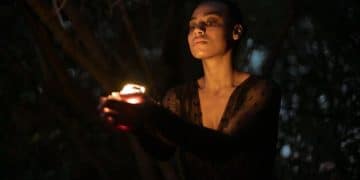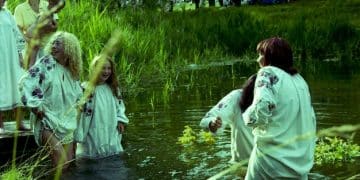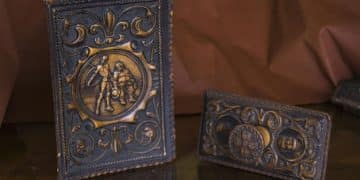Exploring Different Paths in Witchcraft: Wicca, Traditions, and Eclectic Practices
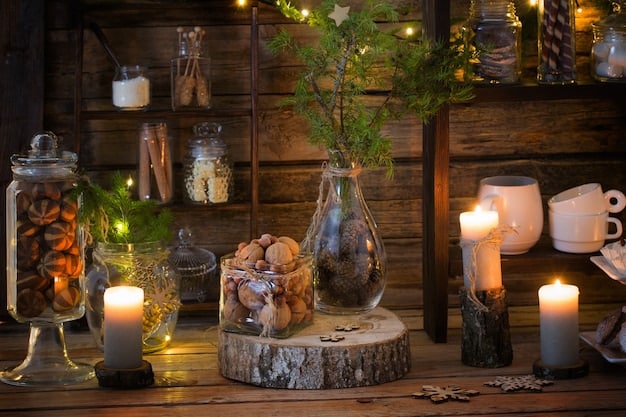
Exploring Different Paths in Witchcraft: Wicca, Traditional Witchcraft, and Eclectic Practices reveals a diverse landscape of magical practices, each offering unique approaches, beliefs, and frameworks for personal and spiritual growth within the witchcraft community.
Embarking on a witchcraft journey involves navigating a diverse range of paths, each with its own unique traditions, beliefs, and practices. Understanding the nuances of these paths is essential for anyone seeking to deepen their spiritual connection and magical skills. Let’s delve into exploring different paths in witchcraft: Wicca, Traditional Witchcraft, and Eclectic Practices.
Exploring Different Paths in Witchcraft: Wicca
Wicca, often considered the most widely recognized modern witchcraft tradition, emphasizes harmony with nature, reverence for the divine as both Goddess and God, and the practice of magic for positive change. Its structure and principles provide a grounded foundation for many practitioners.
Core Beliefs and Principles of Wicca
At its core, Wicca celebrates the cyclical nature of life and the changing seasons, honoring festivals known as Sabbats. Wiccans often follow the Wiccan Rede, “An it harm none, do what ye will,” as a guiding ethical principle. Wicca typically involves:
- Celebrating eight Sabbats that mark significant points in the solar year.
- Honoring both a God and a Goddess in balanced duality.
- Practicing magic responsibly, aligning with ethical guidelines.
Wicca’s emphasis on personal responsibility and ecological awareness makes it an attractive path for those seeking a spiritual practice that harmonizes with the natural world. It provides structure and community, making it accessible and supportive for newcomers.
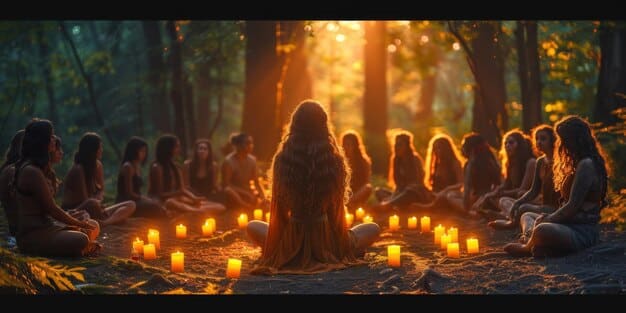
Ultimately, Wicca offers a structured, nature-based spiritual path focused on ethical magic and personal growth. Its emphasis on community and celebration of nature provides a supportive environment for practitioners to explore their magical and spiritual potential.
Unveiling Traditional Witchcraft
Traditional Witchcraft, unlike Wicca, generally refers to various forms of witchcraft that predate the modern Wiccan movement. Rooted in folklore and folk magic, these traditions often differ significantly from Wicca in theology, practice, and emphasis.
Key Characteristics of Traditional Witchcraft
Traditional Witchcraft often involves a more animistic worldview, with a close relationship to local spirits and the land. Some key aspects include:
- Emphasis on working with spirits, ancestors, and land spirits.
- A darker, more folkloric approach to magic and ritual.
- A less structured and more individualistic practice.
Traditional Witchcraft invites a deeper dive into the unseen realms, fostering a potent and intimate connection with the spirits of the land. Its individualistic nature appeals to those seeking a more solitary and autonomous magical path.
Divergences from Wicca
While Wicca often emphasizes deities known by specific names and roles, Traditional Witchcraft typically focuses on nameless spirits or the “Old Gods.” Below are further distinctions:
- The focus on initiation is different. Wicca often has structured rituals, while Traditional Witchcraft may have a more mentorship-based approach.
- Ethics vary widely; Traditional Witchcraft doesn’t necessarily adhere to the Wiccan Rede.
- The cosmology may differ significantly, with Traditional Witchcraft often incorporating local folklore.
In short, Traditional Witchcraft distinguishes itself through its deep engagement with folklore and local spirits, providing a stark contrast to Wicca’s more structured and modern framework. This path is ideal for those drawn to the raw and ancient roots of witchcraft.
Eclectic Witchcraft: A Personalized Approach
Eclectic Witchcraft is a highly individualized path where practitioners draw from various traditions, philosophies, and practices to create their own unique spiritual and magical system. This path celebrates personal autonomy and creative freedom.
Building a Unique Spiritual Practice
Eclectic witches piece together their craft from diverse sources, such as:
- Wicca, Traditional Witchcraft, and other established traditions.
- Paganism, shamanism, and indigenous spiritual practices.
- Personal experiences, insights, and experimentation.
Eclectic Witchcraft emphasizes the individual’s intuition and experience, allowing practitioners to tailor their beliefs and practices to resonate with their personal spiritual needs and preferences. This flexibility empowers practitioners to craft a practice that is truly their own.
The Benefits and Challenges of Eclecticism
The primary benefit of Eclectic Witchcraft is its flexibility and freedom. However, there are challenges to consider:
- Requires extensive research and self-reflection.
- May lack the structure and community found in established traditions.
- The blending of inconsistent beliefs from different systems can cause confusion.

Ultimately, Eclectic Witchcraft is perfect for those who value personal freedom and creative expression in their spiritual and magical practice. However, it requires dedication, research, and a commitment to personal integrity.
Exploring Different Paths in Witchcraft: Ethics and Responsibility
Regardless of the specific path—Wicca, Traditional Witchcraft, or Eclectic Practice—ethics and responsibility play a pivotal role. A strong ethical foundation is essential for any practitioner seeking authentic and meaningful magical work. Exploring different paths in witchcraft: Wicca, Traditional Witchcraft, and Eclectic Practices, we find a common thread of accountability.
The Importance of Ethical Guidelines
Ethical considerations in witchcraft encompass several key areas, including:
- Informed consent: Ensuring all involved are aware and agree to the work.
- Non-manipulation: Avoiding actions that control or coerce others.
- Responsibility for consequences: Being accountable for the outcomes of magical actions.
Ethical awareness not only safeguards against harm, but also enhances the power and integrity of magical practice. By acting responsibly, practitioners align with positive energies and foster personal growth.
Ethical Frameworks Across Different Paths
Ethical guidelines may vary depending on the tradition:
- Wicca often follows the Wiccan Rede: “An it harm none, do what ye will,” emphasizing harmlessness.
- Traditional Witchcraft may focus on honoring spirits and ancestors, integrating their wisdom into decision-making.
- Eclectic practitioners develop their own ethical codes, drawing from various sources and personal values.
In summary, ethics and responsibility are paramount in all witchcraft paths. By adhering to ethical guidelines, practitioners cultivate respect, integrity, and positive outcomes in their magical endeavors.
Practical Considerations for Choosing a Path
Choosing a witchcraft path requires honest self-reflection, exploration, and alignment with personal values. Evaluating what resonates with you spiritually and magically is crucial.
Assessing Personal Preferences and Goals
Consider the following questions when selecting a path:
- Do I prefer structured practices or more freedom?
- Am I drawn to nature-based spirituality or spirit work?
- What are my ethical boundaries and principles?
Take time to explore different practices, read widely, and connect with other practitioners to gain deeper insights. Experimentation and self-discovery are essential components of this journey.
Resources for Further Exploration
Here are some resources to help you explore different traditions:
- Books: Research specific traditions and perspectives.
- Websites: Explore online communities and forums.
- Workshops: Attend events to learn directly from experienced practitioners.
Ultimately, exploring different paths in witchcraft is a personal and transformative journey. By aligning your practice with your values, you can create a powerful and meaningful spiritual connection.
Blending and Adapting Practices
Many witches blend practices from different traditions, creating a personalized approach that resonates with their unique needs and insights. This blending can lead to innovative and effective magical techniques.
Finding Harmony Between Traditions
When combining different practices, consider the following:
- Ensure that the ethical guidelines of each practice align.
- Avoid conflicting beliefs or practices that might hinder progress.
- Integrate elements that enhance your overall spiritual experience.
Blending traditions requires careful thought and respect for the origins and intent of each practice. Approach this process with mindfulness and a commitment to maintaining integrity.
Examples of Blended Practices
Some examples of how witches blend traditions include:
- Combining Wiccan Sabbats with Traditional Witchcraft spirit work.
- Integrating Pagan deities into an Eclectic practice.
- Using shamanic techniques within a Wiccan framework
In essence, blending and adapting practices allows witches to create a path that is both authentic and effective, fostering personal growth and spiritual connection. It’s a journey of continuous learning and refinement.
| Key Aspect | Brief Description |
|---|---|
| 🌿 Wicca | Nature-based, with ethical guidelines and structured rituals. |
| 🔮 Traditional Witchcraft | Focuses on folklore, spirits, and ancestral connections. |
| ✨ Eclectic Witchcraft | Personalized and draws from various traditions. |
| ⭐ Ethics | Essential in every path, guiding responsible magical practice. |
Frequently Asked Questions
Wicca emphasizes nature, ethical guidelines, and structured rituals, while Traditional Witchcraft focuses on folklore, spirits, and ancestral connections. The ethics can also differ profoundly.
Start by researching different magical and spiritual traditions. Then, reflect on your values and personal preferences. Experiment with what resonates with you and craft your unique system.
Yes, as long as you approach magical practice with responsibility, respect, and a commitment to non-harm. Adhering to ethical guidelines ensures positive and meaningful outcomes.
Look for books on folklore, visit local historical societies, and seek out experienced mentors. Online forums and communities can also provide valuable insights and support.
Yes, blending practices is common, but ensure that the ethical guidelines and principles of each tradition align. Use mindfulness and respect to integrate practices harmoniously.
Conclusion
Exploring different paths in witchcraft: Wicca, Traditional Witchcraft, and Eclectic Practices offers a rich tapestry of options for those seeking spiritual and magical growth. Each path presents unique practices and beliefs that cater to different aspects and curiosities.
